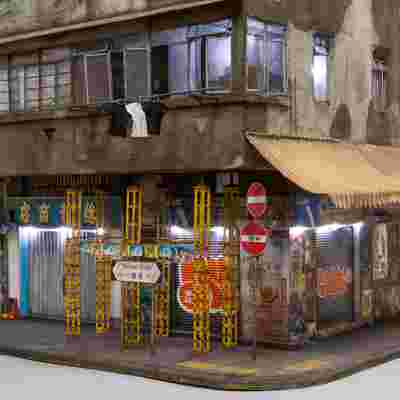While many contemporary sculptors live by the maxim bigger is better—creating massive pieces that fill building lobbies or the lawns of Hamptons estates— Joshua Smith takes the opposite approach. The Australia-based artist builds miniature versions of urban spaces in exacting detail and 1:20 scale. Smith shifted to miniatures two years ago, after spending 15 years as a stencil artist and later running his own gallery. “After the closure of the gallery, I wanted to move into a new direction, and after a bit of experimentation, the urban decay miniatures was the result,” he says.

Smith’s models are built in 1:20 scale.
The artist shies away from shiny, new buildings and instead focuses on decaying or forgotten buildings filled with everyday items, such as clothes hanging out to dry or Chinese takeout containers left on the table. “To me, things such as grime, graffiti, rust, and decay are all layers of time showing a history,” says Smith. For New York’s VOLTA art fair, Smith recreated 23 Temple Street, a building in the Kowloon area of Hong Kong, which he found after hours of scouting on Google Street View. “Initially it was the weird support structure that hooked me, but I loved how the decay and grime of the building had formed,” he says. “The more I looked into the structure and details of the building the more I fell in love with it.” The piece took Smith, working eight to 16 hour days, six to seven days per week, three months to complete.

A close-up of Smith's miniature of 23 Temple Street.
His process involves breaking each structure down into sections and reverse engineering it. “As my miniatures are all [made from scratch], none of the parts are predesigned, so I need to design everything and work out what order I will build it all in,” he says. Smith constructs the base and other architectural elements out of medium-density fiberboard (MDF), while cardboard, paper, styrene plastic, wire, and plastic card are used for the details. The miniature structure is painted with acrylic paint, using spray cans and brushes, and Smith adds weathering pigments to bring the piece to life.

“The most difficult challenge of all is packaging and sending the work,” says Smith. “All of my commissions and exhibitions are all overseas and I don’t sell any of my work locally, so it all needs to be carefully packed and sent.”
Each design requires new methods and approaches. But for Smith, that’s one of the best parts of the process. “I love the problem-solving aspect of working in miniatures, and because I am self-taught, I am constantly coming up with new ways to do things,” he says.









